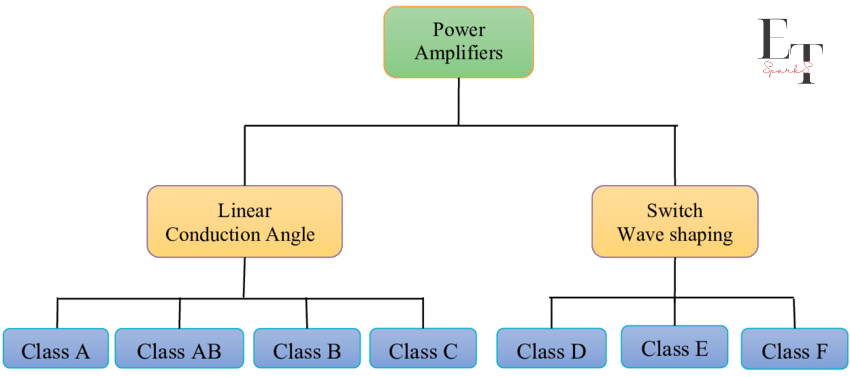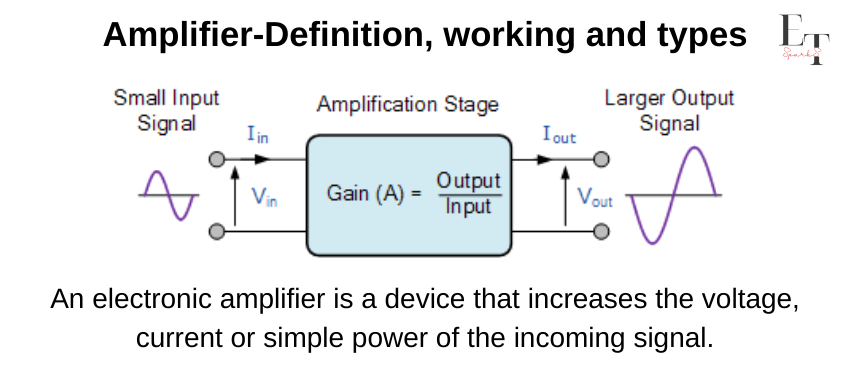Amplifier-Definition, Types and working
An electronic amplifier is a device that increases the voltage, current or simply power of the incoming signal. The process of enhancing the input signal and give amplified signal this process is known as amplification.
Definition: How Amplifiers Work?
Amplification is the process of increasing the power or strength of a signal that is given to an electrical device or circuit. In simple terms, you input a weak signal, and the amplifier boosts it, making it louder and more robust.
Hello, tech enthusiasts! In this post, we will investigate the Engaging universe of electronics, with a focus on one of its fundamental components like Amplifiers- its types, Definition and working principal. Whether you are an electronics hobbyist, a student, or just someone curious about the inner workings of your gadgets, this article aims to simplify amplifiers for you in an informative and engaging manner. Let us enter on this Informational journey!
There are many types of circuits have the amplifiers like as small signal to the large signal and power amplifier. they come in various types each has to specific applications. Let us explore the most common types of amplifiers: Classification is based upon its size, processing speed, I/O configurations, load capacity etc.
Types of Amplifiers:
Current Amplifier:
As name suggest Current Amplifier is a key component in electronics, boosting input currents while maintaining voltage levels. Its applications range from audio systems to medical devices, enhancing audio quality and aiding in medical diagnostics. This essential device plays a crucial role in various electronic systems, ensuring optimal performance.
voltage amplifier:
a voltage amplifier that increases input voltage to produce a higher voltage output. which define as has a high input impedance and a low output impedance,
Transconductance Amplifier:
It has a voltage controlled current source (VCCS). There is usually an additional input for a current to control the amplifier’s whose differential input voltage produce an output current. Simply output current changes upon input Voltage.
Transresistance Amplifier:
It refers as V to I converter, it converts input voltage to output voltage.
Power amplifiers:
Power amplifiers are designed to boost the power of signals. Power amplifiers are crucial components in electronics, designed to increase the magnitude of both voltage and current signals. They are extensively used in applications like audio amplification, RF communication, and high-power industrial systems. Power amplifiers play a vital role in delivering robust and amplified signals for diverse electronic systems.
Sometime amplifier needs to drive a motor or big instruments which required large amounts of power here the power amplifiers are uses. This is achieved through the use of electronic components like transistors or vacuum tubes.
Examples of power amplifiers: audio power amplifiers, servo motor controllers, push-pull Amplifiers and RF power amplifiers.
Operational Amplifiers (Op-Amps):

Operational Amplifiers (Op-Amps) can be used to amplification, filter, sensor signal conditioning, oscillators. also, it can perform mathematical operations such as voltages comparator, subtractor. Op-amp are high gain electronic voltage amplifiers. It has a external feedback components. from Analog computing to audio processing Operational Amplifiers (Op-Amps) are used.
Amplifiers have mostly two input terminals and two output terminals (Common Ground), it has such as a Bipolar Transistor, Field Effect Transistor or Operational Amplifier. Here the input signal and output signal always higher because it is “Amplified”.
Important Characteristics of an Amplifier:
Bandwidth: The frequency range at which the amplifier can operate is referred to as its bandwidth.
Noise: The irrelevant information contained in the output.
Skew Rate: The maximum rate at which output changes.
Gain: The ratio of the magnitudes of the input and output signals. Simply output divided-by the input
Stability: the ability to produce reliable and consistent results.
Linearity: The degree at which input and output signals are proportional.
Efficiency: it is the ratio of output power to the utilized power.
Output Dynamic Range (ODR): The ratio between the highest and lowest usable output levels.
Input output impedance: Input impedance is the opposition to current flow into a circuit, while output impedance is the opposition to current flow out of a circuit.
Ideal Amplifier Model:
The Ideal Amplifiers has mainly Three properties:
- Input resistances (Rin)
- Output resistance (Rout)
- Gain (A)

Ideal characteristics:
- It has infinite gain, bandwidth, no input bias current, and linearity.
- The gain remains same for long time. Gain is not affected by frequency,
- It introduces no distortion, has zero output impedance
- a fixed gain at all frequencies and infinite input impedance. While ideal in theory, but practically it has some imperfections and limitations.
| Characteristic | Value |
|---|---|
| Open Loop Gain (A) | ∞ |
| Input Resistance | ∞ |
| Output Resistance | 0 |
| Bandwidth of Operation | ∞ |
| Offset Voltage | 0 |
Classifications of Power Amplifiers:

The Important classis Are:
Class A Amplifiers:
Class A amplifiers are a type of electronic amplifier used in audio and radio frequency applications to amplify signals. It has high linearity and low distortion characteristics. Class A amplifiers offer excellent linearity. It has Low Distortion One significant drawback of Class A amplifiers is their high-power consumption.
Configuration of Class A amplifiers is ideal for operating mode there is no crossover or switch-off distortion for output even during the negative half of the cycle
Class B Amplifiers:
Class B amplifiers operate with transistors that conduct only half of the input signal cycle, resulting in higher efficiency than Class A amplifiers
Class B Amplifier, also known as a push-pull amplifier configuration. It improves the power efficiency by reducing heat. This amplifier uses in NPN and PNP Transistor configuration.
As compare to class A class B is more efficient. cost and weight are less. Used when very high power is required.
Class AB Amplifiers:
Class AB Amplifier combines the Advantages and benefits of Class A and Class B Amplifiers. Class AB amplifiers are widely used in audio applications, striking a balance between fidelity and power efficiency. Two transistors in the amplifier output stage are pre-biased, allowing each transistor to conduct 180o to 360o of the time.
Class C Amplifiers:
Class C Amplifiers are conduct less than half of the input signal cycle (less than 180 degrees). Because this operating zone goes beyond the class B operating point (78.5% efficiency and 180° conduction angle), They are highly efficient but have low linearity, Class C Amplifiers are commonly used in single carrier fixed Radio Frequency (RF).
Classifications :Summery
| Type of Signal | Type of Configuration | Classification | Frequency of Operation |
|---|---|---|---|
| Small Signal | Common Emitter | Class A Amplifier | Direct Current (DC) |
| Large Signal | Common Base | Class B Amplifier | Audio Frequencies (AF) |
| Common Collector | Class AB Amplifier | Radio Frequencies (RF) | |
| Class C Amplifier | VHF, UHF and SHF Frequencies |
Frequency Asked Questions [FAQs]:
What are the applications of amplifier?
Ans: They have applications in process control, communications, computers, power and signal sources, displays, and measurement systems, among other things.
Is an amplifier AC or DC?
Ans: Because audio is alternating current, amplifier output is also alternating current. That AC output “could” include a small amount of unintended DC component, but it is primarily AC.
Which IC is used as power amplifier?
Ans: Power amp ICs such as the LM3886 and TDA7293 are popular, and for good reasons.
Follow to the blog ETechSpark.com for more articles on electrical engineering, electronic and tech updates.
please leave your question in the comment section, give us your valuable feedback.
